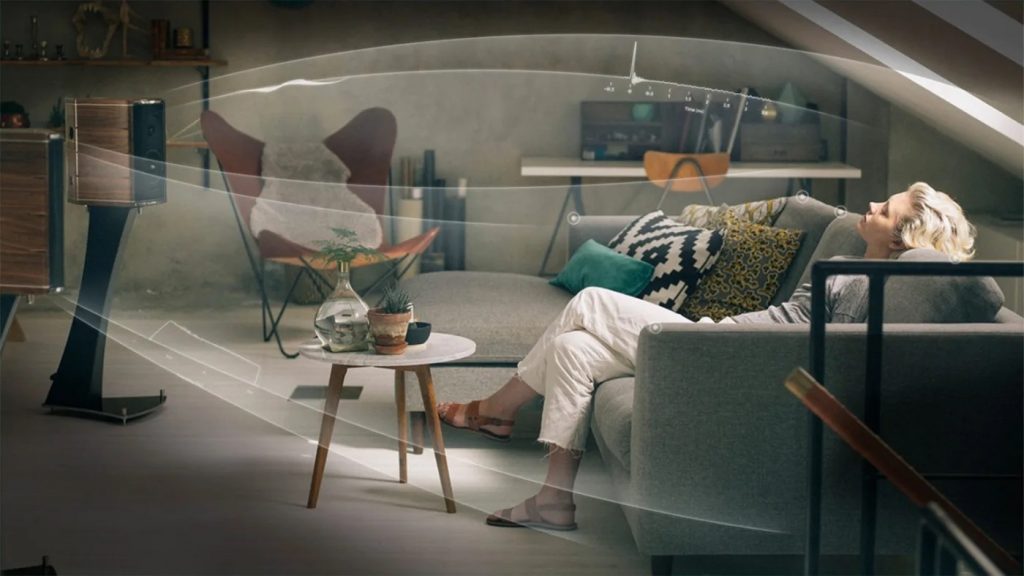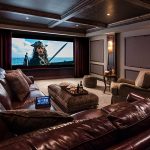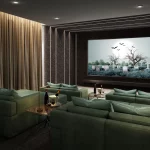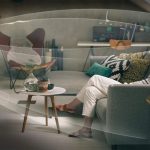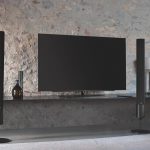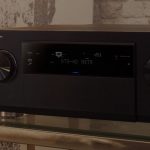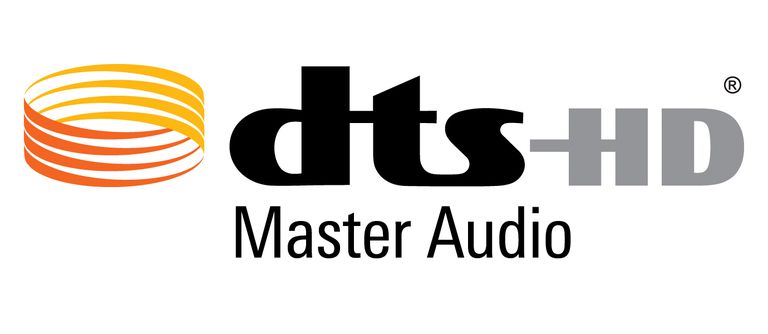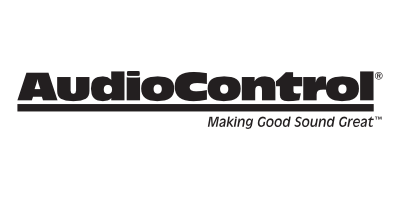One of the realities of buying an AV receiver or surround sound processor these days is that a quick look at specifications, streaming features (or lack thereof), and performance is not enough to make an informed purchasing decision. Now more than ever, the type of room-correction software built into or supported by a preamplifier or receiver probably heavily influences the choice of audio components for the home theater system and is important for room acoustics.
In the days of 5.1 or 7.1, this was not necessarily the case for everyone; but with the advent of object-based surround sound formats such as Dolby Atmos and DTS:X, where you are likely to place speakers in the ceiling that differ radically from the timbre of the main speakers or bounce sound off the ceiling to achieve the surround effect from above, automatic speaker setup functions and room correction software are almost a necessity.
So Many Possibilities
On the surface, all the different autocalibration systems, from Audyssey to Anthem Room Correction, MCACC to YPAO and newer solutions such as Dirac, seem similar in implementation. Each requires you to place a microphone in the room (either at the main listening position or at different points in the room, depending on the level of sophistication of the system) that measures the test tones reproduced by each of your speakers and then uses these measurements for different purposes.
First, most automatic speaker setup systems will automatically adjust the relative levels of all speakers so that the center, main speakers, surround speakers, overhead speakers, and subwoofer all sound at the same volume. Most will also adjust the crossover points between the satellite speakers and the subwoofer. Then it will estimate the distance of each of the speakers from the main listening position and adjust the delay settings of the receiver or processor accordingly. In this way, the sound from each speaker reaches your ears at the same time.
Second, these measurements are used to determine what deleterious effects the acoustics of your room are having on the performance of your speakers. The systems then apply equalization to the speakers to “correct” amplitude response problems.
Environmental Correction Systems
More sophisticated room correction systems also apply filters (finite impulse response or infinite impulse response or, in some cases like Dirac Live, a combination of them) in an attempt to correct timing errors caused by the speakers and/or the room. In other words, these filters are designed to compensate for the fact that sounds of different frequencies, intended to reach your ears at the same time, do not, for one reason or another.
It is worth noting, however, that no digital room correction can compensate for all the acoustic problems in a room.
To understand why, we need to divide the audio spectrum into two different parts and analyze them separately (apologizing in advance to the acousticians present for the gross simplification that follows). From 20 Hz to about 200 or 300 Hz, standing waves are your greatest enemy. Standing waves are an inevitable product of speaker placement in an enclosed, rectangular space. At these low frequencies, reflected sound waves from the room geometry interfere with sound waves coming directly from the subwoofers and/or speakers, causing the volume to increase in some places in the room and decrease in other places, with different dips and peaks depending on the frequency.
In other words, even if your subwoofer creates low-frequency sounds with the same volume level across the entire bass spectrum, a 50 Hz tone might be twice as loud in your listening position, while an 80 Hz tone might be half as loud. If you move to another position in the room, the opposite might be true (probably not exactly, but you get the point).
This is mainly determined by the size and shape of the room, as well as the position of the speakers. Standing waves are also very difficult (if not impossible) to combat with physical acoustic treatments alone, unless you completely change the architecture of the room, which makes digital room correction the ideal solution for dealing with them.
Half of the Problem
Or perhaps it would be more accurate to say that environmental correction is the ideal solution to solve at least half the problem. While equalization can easily handle annoying bass boosts caused by standing waves, not all room correction systems can effectively handle bass dips caused by interference. In other words, if the size and shape of your room means that, for example, 80 Hz tones almost disappear in your favorite location, digital room correction is not the best solution to solve the problem.
It is much better to move the subwoofer, rearrange the furniture, or add another subwoofer to the system-not to generate more bass, but to have more even bass coverage, with one sub filling in the gaps caused by the placement of the other. However, when it comes to combating boomy, bloated bass caused by standing wave reinforcement (in other words, the crest of a reflected wave meets the crest of a direct wave right near the main listening position), many digital room correction systems can work wonders.
Above about 200 or 300 Hz, the effects of the room on sound reproduction have less to do with the size and shape of the space and more to do with the qualities of the surfaces within it, that is, how reflective, absorbent, or diffusive they are and where they are placed. Here we get into controversial territory, because not everyone agrees that a digital environmental correction system based on microphone measurements and calculated equalization curves can successfully solve problems at these frequencies.
As acoustical engineer and president of Performance Media Industries Anthony Grimani explains, “An omnidirectional microphone does not listen like a human being. The main difference is that a human being hears high-frequency sounds as primarily directional, directly from the speaker, and low-frequency sounds as integrated from the speaker and the room. And then, between the low and high frequencies, there is a juncture where these different ways of hearing gradually transition from one to the other.” Needless to say, a microphone does not hear things this way and it takes a lot of processing power and sophisticated filtering to compensate for this.
What the Experts Say
Some acousticians agree that room correction should not be applied above this transition point, especially since our brains are perfectly capable of compensating for things like the difference between direct and reflected sound above 200 or 300 Hz. A great concert grand piano sounds like a great concert grand piano no matter where you put it; you don’t have to equalize it differently depending on the room. Similarly, whether you and I are talking in an anechoic room or a tiled public bathroom, you will recognize my voice as my voice. That is why those of us who are not too enthusiastic about many digital environmental correction systems describe their results as “dead” or “boring.”
That said, the best digital environmental correction systems-those with higher filter resolution and smarter filter application, and those that measure not only the relative loudness of different frequencies but also the timing of when those frequencies reach the microphone-can do a good job of counteracting some acoustic problems in the higher frequencies. However, they cannot effectively solve problems such as long reverberation decay.
If you play guitar, you are probably familiar with the effect that long decay can have on the sound. If not, sit in your room and sing a few notes. If your voice hangs in the air for a while, it means you are listening to a long decay. Or you can stand in the middle of the room and clap your hands. If it sounds like you are in a cathedral or a parking lot, no amount of digital room correction can effectively compensate for this. You will have to invest in absorbent acoustic treatments for your room, whether professional products or simply strategically placed curtains.
Good digital room correction can, on the other hand, combat ringing artifacts (a bit of echo that accompanies high-frequency sounds). Moreover, as I mentioned earlier, the introduction of object-based surround sound formats such as Dolby Atmos and DTS:X has made digital room correction more important (indeed, more necessary) than ever.
Conclusions
Of course, not all digital environmental correction systems are the same, and not all treat different acoustic artifacts in the same way. For this reason, it is worth discussing some of the most popular (and even some of the most advanced) environmental correction systems individually.
This is by no means a comprehensive list; the intent is only to give you a selective overview of some of the different environmental correction systems you might come across when purchasing a new AV receiver or processor and how the market has changed in recent years.
Audyssey
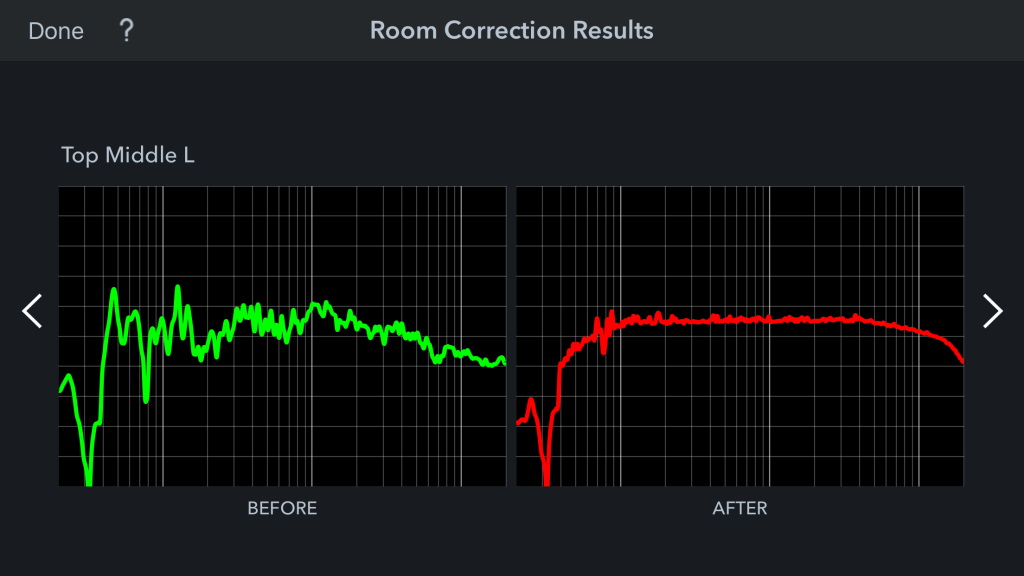
It may not appear on as many products as it used to, but Audyssey is still the first name that comes to mind when you think of “room correction.” The Audyssey platform can be found in products ranging from mid-range and entry-level Denon AV receivers to Wisdom Audio’s $6,000 SC-1 system controller. Of course, the two ends of the spectrum are not covered by exactly the same Audyssey technology. The company’s automatic calibration comes in several variations. Fortunately, the simplest solution, 2EQ, seems to have been eliminated. 2EQ, completely ignored the low frequencies that benefit most from digital room correction and had a limited number of filters for high frequencies.
The standard MultEQ solution improves things somewhat, with twice the number of filters for the high frequencies and a necessary correction for the low frequencies, but according to many it seems that MultEQ does more harm than good to the mid and high frequencies in an acoustically acceptable room.
If, however, one switches to MultEQ XT, the talk becomes serious. With eight times the high-frequency filter resolution of the MultEQ, the XT allows for more precise equalization and, as a result, a less processed, less lifeless, and more spacious sound. In addition, it allows eight metering positions (compared to six for MultEQ). More metering positions means that the system has a more complete view of the entire listening space, allowing it to make smarter decisions about which problems to correct or not correct.
For most consumers, MultEQ XT32-usually included only in high-end receivers-is a really good product, with 256 times the high-frequency filter resolution of MultEQ and four times the bass filter resolution. Like MultEQ XT, it also offers eight measurement positions and, like MultEQ XT, gives professional installers access to MultEQ Pro, a kit that includes a professional-grade microphone and preamplifier and allows up to 32 measurements in the room.
MultEQ Pro also allows the installer to compose custom EQ curves more suited to the listening environment and user preferences, rather than the unique EQ curves of 2EQ, MultEQ, XT and XT32.
Nowadays, if you find Audyssey in a new receiver, it is most likely a Denon or Marantz, which now group the room correction system along with other Audyssey technologies into four levels called Audyssey Bronze, Silver, Gold, and Platinum. The Bronze includes MultEQ, Dynamic Volume and Dynamic EQ. Silver includes MultEQ XT, Dynamic Volume and Dynamic EQ. The Gold also includes MultEQ XT, as well as Dynamic Volume, Dynamic EQ and Dynamic Surround Expansion. Audyssey Platinum boosts MultEQ XT32, Dynamic Volume, Dynamic EQ, Dynamic Surround Expansion, HT Sub EQ and Low Frequency Containment.
The new Denon and Marantz receivers have been updated to support the MultEQ Editor App for iOS and Android that allows you to adjust target curves and set a maximum EQ frequency above which EQ is not applied. At the time of writing, the $19.99 app for iOS and Android is still fairly new, so expect some bugs and issues, but it is a huge step toward alleviating many of the concerns people have about Audyssey.
Dirac Live
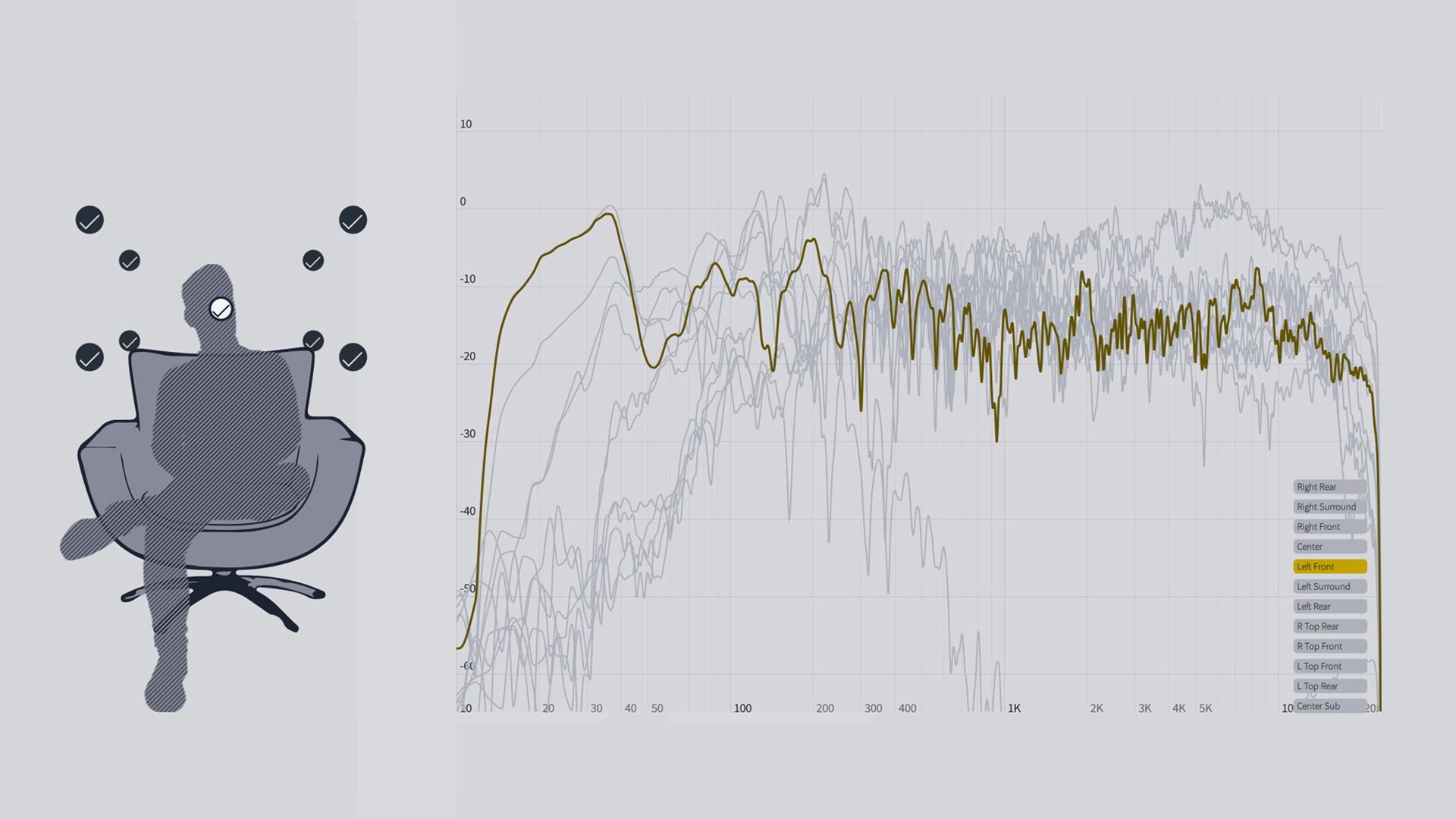
Dirac is one of the most popular room correction systems, but it is also appearing on new equipment at an increasing rate. You can find the system on everything from Emotiva’s XMC-1 to the upcoming RMC-1 home theater processor to DataSat’s $23,000 RS20i, via offerings from Arcam, AudioControl, Lexicon, NAD, StormAudio, and Theta Digital.
Will we start seeing it soon on other mass-market receivers? Perhaps.
One thing sets Dirac apart from the room correction systems found in most consumer units: the fact that it requires a Windows or OS X computer to operate. It is also a bit more complicated than most basic environmental correction systems, as it requires you to adjust input and output gain before taking measurements; also, if clipping occurs at any point in the process, you have to backtrack and make adjustments. The software also allows you to change target curves by pair of channels (or individually for the center speaker and subwoofers) and easily set a maximum frequency beyond which no correction is applied.
Like Audyssey (but unlike other popular room correction systems, such as Anthem Room Correction), Dirac Live works in the time domain, which means that it does not just change the equalization of the processor or receiver output, but applies filters that compensate for time distortion. Unlike Audyssey, which relies on finite impulse response filters, Dirac Live uses mixed-phase filters to achieve superior time alignment or impulse response correction. In light of this and my further experience with (and understanding of) Dirac Live, I have recently changed the way I use the software. Until recently, I would sculpt my filters to apply the correction no further than 400 or 500 Hz. Today I find that I get better results by applying filters that cover the entire audible frequency range, but I spend much more time sculpting them.
Below about 400 or 500 Hz, I let Dirac set its own curve points. Above this region, I create a curve that very carefully traces the general lines of the room response of my speakers, while smoothing out the most noticeable oscillations. In other words, I maintain the voice of my speakers by alleviating room damage and apply time correction to the entire audible frequency range.
Because it requires nine microphone measurement points that form a kind of elongated cube (yes, you have to raise and lower the microphone as you move it forward, backward and side to side), plus the fact that the measurement and filter creation screens can be quite dense with data and choices, Dirac Live is not for the faint of heart. But it is currently ranked number one among the environmental correction systems preferred by professionals in the field.
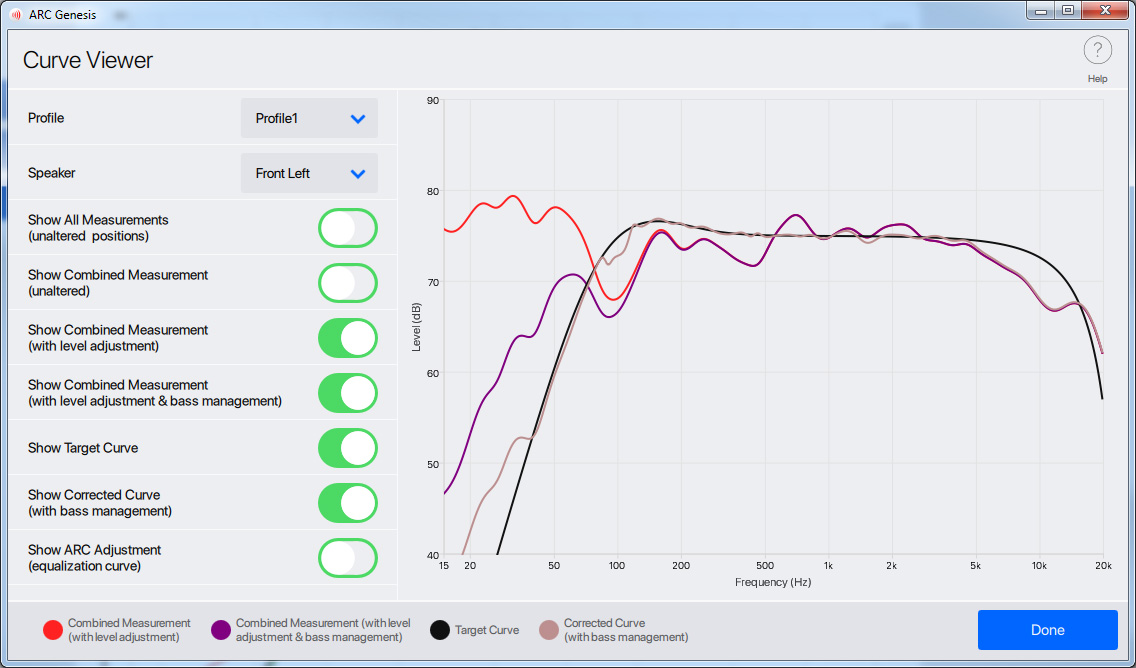
Anthem Environment Correction
Tied for first place? Anthem’s proprietary environmental correction system. ARC is obviously limited to use with Anthem’s preamplifiers and receivers, as well as with Paradigm and MartinLogan’s wireless music systems and soundbars. As mentioned, ARC does not work in the time domain but, in my opinion, it can handle standing waves better than any other room correction system, even Dirac.
In its most complete form, ARC requires the use of a Windows computer, and the supplied microphone is a beast compared to the small field hockey hat-shaped microphones supplied with most environmental correction systems. The use of a computer gives ARC much more processing power to make the measurements and create the filters. Perhaps because of this fact, ARC has never failed to perfectly zero in on crossover points and speaker levels in the dozens of times I have used it both on my D2v 3D processor and on all of the company’s receivers I have tried.
What I really like about ARC, though, is that it allows you to make all kinds of decisions about crossover slopes, room gain, and, of course, maximum EQ frequencies. In my main home theater, with the Anthem D2v 3D, I always found a maximum EQ of about 400 Hz ideal. In my secondary home theater at the back of the house, I set the maximum equalization of my Anthem MRX 1120 to 600 Hz so that the system can smoothly handle a peak in that room around 500 Hz.
It should also be noted that until the release of the second generation MRX receivers, Anthem did not give ARC different names for its different implementations. If ARC was used on the D2v, it worked to its full capacity; if ARC was used on the first-generation MRX 500 or 700, the same measurements were obtained, but fewer filters were applied. Also, originally ARC required that the connection between the PC and the pre/pro or receiver be in the form of an RS-232 connection, which required the use of a USB-to-serial adapter for most users.
With the introduction of the new MRX 510 and 710 receivers, Anthem also debuted ARC M1 (now known simply as ARC 2), which takes advantage of more receiver filters (not as many as D2v is capable of, but still more), as well as faster calibration and networking capabilities. The company has also recently introduced ARC for iOS devices, which may not benefit from the same quality of microphone and functionality, but certainly offers greater intuitiveness and ease of use.
Trinnov
Acoustic Correction is the name Trinnov gives to its environmental correction system, and for all intents and purposes I should hate it. Trinnov works not only in the frequency and time domain, but also in the spatial domain. The included microphone is actually a microphone array that includes an arrow that must be pointed directly at the screen.
During measurements, the system maps the position of your speakers in three dimensions and can shift the perceived position of one or more speakers to compensate for less than ideal placement. It can take left and right front speakers that are too close together or too far apart and virtually move them to a perfect distance of 22.5 or 30 degrees from the center channel.
It can even bring the image of the center speaker down to the level of the left and right main speakers if it is placed too far down (or, for goodness sake, up) from the TV set. The effect is really eerie, and again, on paper, I don’t like the idea at all. But in practice it looks great. A few years ago I reviewed a Sherwood Newcastle receiver that included the Trinnov Optimizer, and I absolutely fell in love with the effect.
The system, in its newest form, also offers impulse response correction and magnitude on par with (or technically better than) Dirac Live and allows you to use all kinds of tools to shape the target curve that I described in the overview of that system, at an even finer level.
There is one important caveat, however. Outside of select systems such as JBL Synthesis’s very expensive SDP-75 processor, Trinnov Optimizer is only available on Trinnov’s expensive 16-channel or more preamplifiers.
AccuEQ
In recent years, Onkyo and Integra have gone from being licensees of Audyssey to introducing their own room correction system called AccuEQ. Early implementations of the system were deficient to say the least, as they did not apply equalization to the front speakers or subwoofer. More recent versions, however, have improved dramatically, and in its current form AccuEQ is very good indeed. One distinguishing aspect of the system is that it performs two sets of measurements. The first cycle is used to adjust levels, delays, and crossovers, while the second is used to calculate EQ curves. In my experience, unlike previous implementations of AccuEQ, the latest version of the software performs most of the correction on the low frequencies, leaving the mid and high frequencies untouched. However, it struggles a bit to set the crossover frequencies correctly, so be prepared to change them manually.
Pioneer MCACC
MCACC (or Advanced MCACC) is Pioneer’s proprietary environmental correction system, which has improved significantly in recent years. It is currently available in three variants. The basic, unlabeled version of MCACC merely measures speakers, balances levels, sets the crossover, changes rudimentary EQ settings, and applies phase correction to the subwoofer. On the other hand, it does nothing to combat standing waves, since no equalization is applied to the subwoofer. Advanced MCACC and MCACC Pro, on the other hand, do so.
Advanced MCACC also adds phase control for each speaker, more advanced equalization (including sub equalization), and some features such as speaker polarity control. MCACC Pro is the piece de resistance, with advanced features such as Auto Phase Control Plus (filters that apply time correction selectively across the entire frequency range), independent subwoofer metering and correction, advanced bass management for object-based surround systems, and the Precision Distance tool that allows you to adjust speaker distances (and thus delays) to the millimeter level.
I am speculating purely, but I wonder how much longer MCACC will be around. I am not saying that Pioneer is a problem, nor that MCACC has shortcomings compared to other proprietary solutions from Onkyo, Yamaha, Sony, and the like. This consideration is based solely on the fact that Pioneer has recently developed a cooperative relationship with Dirac, under which the former serves as a distributor of the latter’s software in Japan.
YPAO (Yamaha Parametric Room Acoustic Optimizer)
YPAO, as you may have guessed from the name, is Yamaha’s proprietary room configuration system. It comes in two variants: one called simply YPAO and the other YPAO R.S.C. The former measures speaker levels and delays and applies parametric equalization with varying degrees of success. YPAO R.S.C., on the other hand, also applies impulse response filters to combat reflected sound. More recently, Yamaha has added the ability to change its parametric equalization settings on YPAO R.S.C., with the impulse response filters being copied from its calculated settings.
You will probably find YPAO today only on the lower-priced Yamaha AVRs, while YPAO R.S.C is more commonly found from mid-levels up. If you’re looking for a Yamaha receiver, there’s another key thing to consider: The YPAO R.S.C. comes in two variants. One with multi-point measurements and one that measures from a single seating position. In my opinion, the latter does not do a very good job with levels and distances, so it is probably worth switching to a model with multipoint measurements. Unless you intend to set up your receiver in a completely manual mode.
Automatic Digital Cinema Calibration (DCAC)
Another proprietary environmental correction system found in mass-market receivers is Sony’s DCAC (available in variants such as DCAC EX and ADCAC). This system is frankly a bit of a mystery to me, since Sony does not publish much clear information about what it does and how it works. In my experience, it is a system that works poorly or badly, and the level and speaker distance settings always need some tweaking. Also, the new dual microphone that comes with units like the STR-ZA5000ES can give very inconsistent measurement results from one run to the next, even with the microphone placed in the same position. The one positive aspect of DCAC is that it does not seem to alter the signal above 500 Hz or so. The downside is that sometimes automatically calculated settings can exacerbate standing wave problems, defeating the purpose completely. Ultimately, the only thing the DCAC could really benefit from is the ability to take multiple measurements, but all the Sony receivers I have reviewed so far allow only one microphone position.
Room EQ Wizard
A popular solution for do-it-yourselfers, Room EQ Wizard (or REW) is not for the faint of heart. However, if you have a receiver that allows you to dial in your own parametric EQ settings and don’t mind digging deep, it offers pretty amazing results. REW requires the purchase of a USB audio interface. In this case, PreSonus AudioBox is a popular choice, but other interfaces such as the Tascam US-2 2 also work great, provided you have phantom power. Plus, it requires a calibrated microphone (like the Behringer ECM8000 microphone, if you’re looking for an inexpensive option). And the great thing is that the software itself is free. Again, this can be a daunting option at first, as the software doesn’t take you by the hand at all, but there are tons of excellent video tutorials and comprehensive help files on the REW website.
Perfect Bass Kit
Paradigm/Anthem also has another proprietary environmental correction system called the Perfect Bass Kit, which as you may have guessed works only on Paradigm and MartinLogan subs. Think of it as a simplified version of ARC (with simplified connections; it includes the same USB microphone as ARC and requires only a USB connection from the computer to the subwoofer). The advantage of the PBK is that it applies room correction where the room needs it most: in the low frequencies. The downside, of course, is that it applies only to the subwoofer channel, which is probably crossed at 80 Hz by your processor. So you can’t detect problems in the main channels that generate bass between the crossover frequency and that critical point between 200 and 300 Hz where standing waves can plague upper bass performance.
EQ ambiente Sunfire
Sunfire doesn’t have a fancy name for the ambient equalization system included in many of its subwoofers, but it doesn’t need one. It’s fast. It is simple. It does its job and solves most room acoustic problems. But, as in the case of the PBK, it can only apply correction up to the crossover point between the subwoofers and the satellites.
As already anticipated, this list does not take into account many other noteworthy room correction systems, from HARMAN’s ARCOS to Lyngdorf’s RoomPerfect. So does Meridian’s excellent MRC, as well as other bass-only solutions such as Velodyne’s SMS-1.
If you would like to find out more about this topic, contact us now!
Don’t miss the opportunity to experience the excitement of a high-quality Dolby Atmos system and book your free demonstration now!

